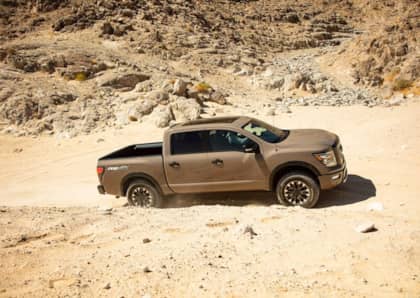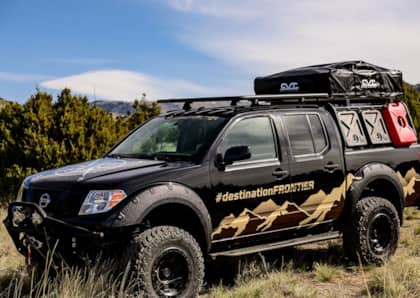From Alpha-T To Titan: Charting Nissan's Journey To Building A Full-Size Pickup
The dominance of Detroit's Big Three in the full-size pickup segment can't be overstated. Collectively, Ford, Ram (previously Dodge), Chevrolet, and GMC represent well over 90 percent of truck sales, leaving only crumbs to be contested between interlopers from overseas.

In the late '90s, however, Nissan thought it saw an opening. After research and polling showed that as much as 40 percent of truck owners were willing to switch brands at any given time, the Japanese automaker decided to test the waters with an all-new pickup that was larger than anything it had offered in America before. Dubbed the Titan, it appeared for the 2004 model and beat Toyota to the full-size game by several years (with its rival still offering the 7/8ths-sized first-generation Tundra).
How did the Nissan Titan go from design sketch to reality? Let's take a look at the Titan's path to the full-size truck market.
Shared Platforms, New Looks
The decision to go ahead with the project that would eventually become the Titan was made in 1999. A mere two years later, the first fruits of the truck's development program would be unveiled at the auto show in Detroit in the form of the Nissan Alpha-T Concept.

It was clear that the Alpha-T's wild sci-fi looks wouldn't translate directly into a production model. And yet, there are many elements of the early-2K concept's visual persona that found their way to the first-generation Titan's sheet metal. Specifically, the sloped grille and the general shape of the cabin were quite similar, along with the rear-hinged doors that opened almost 180 degrees to allow access to the second row of accommodations. Other more fantastical features, such as high-cut fender openings, a sliding bed, and a tailgate lift, didn't carry over.

Underneath the skin, the Titan's engineering team was able to lean heavily on the F-Alpha platform used for full-size SUVs like the Armada, which was fully-boxed and had its suspension mounting points tucked up high out of the way of off-road obstacles. Nissan had extensive experience building rugged all-terrain rigs (such as its globe-trotting Patrol SUV), as well as a deep well of compact and mid-size truck knowledge to tap into when modifying the F-Alpha chassis for full-size duty.

Another unexpected bonus for the upcoming Titan was the decision to shoehorn in an aluminum-block, 5.6L V8 engine that was good for 317hp and 385 lb-ft of torque. Although the vehicle was limited to a single drivetrain configuration, Nissan was hopeful that the advanced 32-valve, overhead camshaft design would show well against the lower-tech pushrod engines offered by the majority of the competition.
Innovation was also a keyword when configuring the Titan's practical side. Headed by Nissan Design America, Inc. in California, the clean-sheet approach offered the chance for a flat floor, huge amounts of interior storage, and a lockage storage bin inside the bed itself.
A Big Splash, And Then…Nothing
The Titan would follow the Alpha-T onto the stage in Detroit in 2003, with Nissan boss Carlos Ghosn making the introduction to further emphasize how serious the company was about its pickup program. Offered in both extended and four-door body styles, along with a trio of options packages (including off-road and towing setups), as well as a respectable range of features, the Titan was able to meet its domestic competitors head-on in most areas while rising above with its advanced V8 engine.

Still, despite its billion-dollar U.S. factory investment intended to produce not just the Titan but other Nissan trucks and SUVs, the automaker was somewhat hesitant in rolling out the full-size pickup. Production for the first year was limited to 85,000 examples, and from there the Titan was unable to match its early success. By 2009 sales had dwindled to just 19,000 units a year.

What happened to the truck that started out so strong? Nissan's lack of investment in terms of diversifying the drivetrain options for the Titan put it in tough to match vehicles like the Ford F-150 and the Chevrolet Silverado, each of which delivered a number of different engine choices at varying price points and power levels. The lack of a heavy-duty division also limited the Titan's appeal to commercial buyers, which traditionally form a respectable percentage of yearly sales.

The Nissan Titan would continue nearly unchanged (aside from a few cosmetic tweaks and feature upgrades) for nearly 15 years before a second generation model would make it to showrooms. Despite its strong start and the sound engineering behind its debut, the slow fade of the Titan is destined to go down in history as one of the auto industry's biggest 'what ifs'.
More From Driving Line
- Curious about the redesigned Nissan Titan? Here's our take on the most recent generation PRO-4X off-road special.











